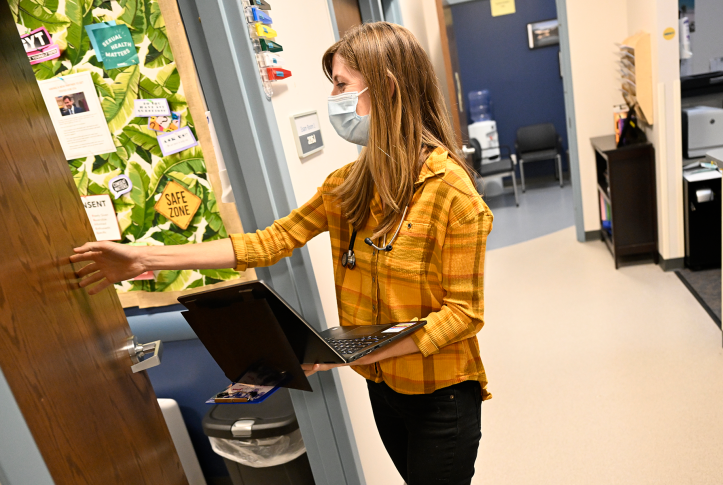Acknowledging that health care contributes significantly to environmental pollution and climate change, on December 3, the United Nations will host its first Health Day, with calls to promote health benefits of emissions reduction and for financing climate action in health care. At the event, the U.S. plans to announce new health care commitments, including proposed actions by federal health systems to reduce their greenhouse gas emissions related to clinical care.
There are several reasons all clinicians should get involved in reducing health care’s contributions to climate change. First, climate change leads to public health damage — reducing this damage is a moral, professional, and public health imperative for clinicians. Principles of medical ethics, as stated by the American Medical Association, call for physicians to “participate in activities contributing to the improvement of the community and the betterment of public health.”
Second, clinicians are among the most respected professionals in society and can influence patient care, policy, and advocacy. Their leadership role can serve as an example for other sectors that intersect with health, including food, agriculture, transportation, plastics, waste, and fossil fuels.
Third, reducing emissions fits squarely within the quality, safety, and value equation for clinicians. Impact from climate change causes preventable harm to patients, the public, and the planet. Climate change impact could create harm similar in magnitude to that caused by medical errors. Both issues are complex problems and require systemwide solutions that involve people, processes, data, technologies, and culture change.
Clinicians can work on three levels to lead climate action: individual clinical practice level, health care organization level, and professional, industry, regulatory, or government level. Work on all three is essential for reducing emissions from health care services and achieving environmentally sustainable health care.
At the individual practice level, clinicians can provide lower-emission care, such as encouraging more environmentally friendly inhalers and choosing more reusable vs. single-use medical devices. When appropriate, clinicians could also consider more nonpharmacological and noninvasive treatments such as physical therapy, yoga, and meditation compared with potentially unnecessary procedures with questionable benefits. This can reduce low-value and often wasteful care. Clinicians can use recommendations from the Choosing Wisely campaign that provides lists of frequently overused tests and treatments that are potentially harmful to patients and unsupported by scientific evidence.
At the health care organization level, clinicians can create sensible policies for infection prevention that encourage safe reuse of medical supplies — the current overuse of plastics and subsequent pollution is harming human and environmental health. Clinicians can also educate trainees and influence purchasing decisions for their clinic or hospital. The COVID pandemic showed how supply-chain issues are now part of the quality and safety conversation; having a resilient supply chain requires clinical input. Additionally, clinicians should collaborate closely with their institution’s sustainability teams that may include people from environmental compliance, engineering, buildings, and energy. For instance, the VA has successfully implemented the Green Environmental Management System program that coordinates organizational sustainability efforts, but clinical services and clinicians are not typically well-integrated into this team and its activities.
Clinicians can help implement best practice tools, guides, and strategies. They can influence their leadership to implement guidance recently developed by the National Academy of Medicine and the Agency for Healthcare Research and Quality. They can also take on sustainability leadership roles to guide organizational actions and operational improvements and implement best practices into clinical care.
In the policy space, clinicians can take on leadership roles in local, national, and global policy and regulatory work. This can help other clinicians get on board. If all health care organizations measured and reported their greenhouse gas emissions transparently, progress could be tracked. However, the path to implementing such a policy is not clear, other than in federal health systems. Clinicians could facilitate this by working to develop and implement policies to enable standardized measurement and benchmarking nationally.
Leveraging clinician leadership to reduce the impact of climate change will require resources, tools, and changes to the current system. Transforming clinical practice requires behavioral and technical interventions that support clinicians in switching to environmentally friendly products and services. Information systems and electronic health records must be modified to provide point-of-care decision support interventions that nudge clinicians in the right direction. Pathways to provide clinicians with performance data feedback on specific climate or sustainability indicators could also help build awareness and enable change.
Health systems research is needed to generate evidence on the most effective strategies to measure and reduce emissions and how to scale such strategies. Scientific knowledge in this area is not robust — metrics of overuse, low-value care, and other climate and sustainability-related performance need to be developed. The recent Lancet Commission on Sustainable Healthcare has brought together experts, including clinicians, to develop approaches to measure sustainable health care.
All clinicians need to go beyond diagnosing and treating patients harmed by climate change and environmental pollution. Using example strategies described in this blog post, clinicians must become leaders of climate action and accelerate progress to protect their patients, the public, and the planet from harm.




